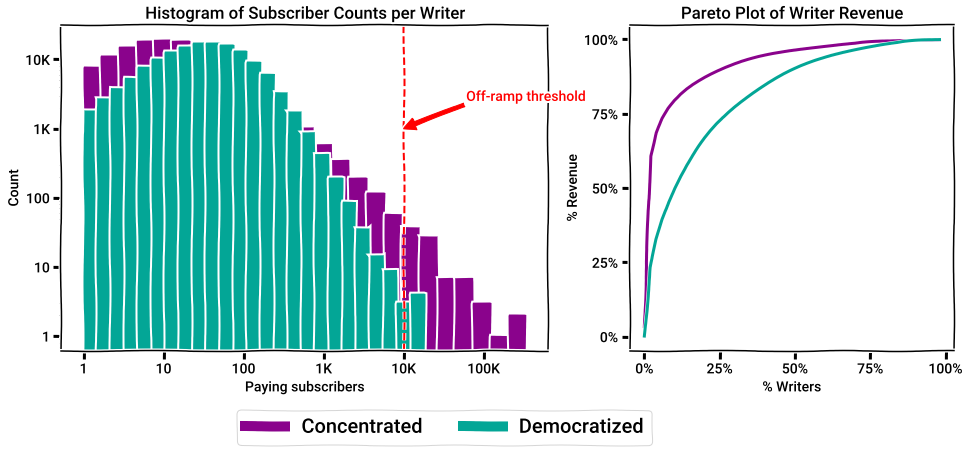The future of paid newsletters on the internet: Concentrated or Democratized?
The success of Substack will depend on if they are able to reshape the way we produce/consume each other’s content. A simple framework I use for thinking about the future of the newsletter landscape, is to ask if we will live in a world of:
- Concentration:
- the market for monetizing writers mostly concentrated in only a very few popular personalities; typical writers have fewer than 100 paying subscribers, only a small fraction have more than 1,000 subs[1]
… or instead a world of:
- Democratization:
- large number of monetizing writers on Substack, each with a small but dedicated long-term audience; the typical writer has between 100-1000 paying subscribers
Precisely which of these versions of the future ends up being the real one will dramatically affect the market for paid writing. For example, if the future of newsletters is concentrated, then most of the revenue (and economic leverage) in the market lies with top writers. A number of agencies and services is already starting to emerge around superstar internet writers (e.g., Letterhead, Ghost, ConvertKit). Note in this future, Substack is merely one of many players seeking to serve the needs of popular writers with loyal audiences. I’ve written previously on how Substack will struggle to win this competition in a way that results in outsized profits.
If, on the other hand, the future of paid newsletters is democratized, then most of Substack’s profits will come from a set of writers for which the value-add of the platform and the cost of their fees are in balance.
Visualization
The graphics below represent these two scenarios visually. I’ve simulated data corresponding to each writer’s annual income by assuming the distribution of subscribers comes from each of these two worlds. In each scenario, the total market for paid newsletters is assumed to be $1B annually; in the democratized scenario, this revenue is distributed fairly evenly among the population of writers; in the concentrated scenario, most of this money is earned by just the top few percent of writers.

Note: The off-ramp threshold in the figure above refers to the theoretical level at which Substack’s cost exceeds its value for most writers.
Whither the future?
With Substack’s current strategy, a bet on the platform is really a bet that the world of monetizable writers has the potential to be democratized. Of course, Substack is aware of this and is trying desperately to create a robust market in the long tail of paid online content; their recent announcement about the launch of Substack Local indicates a clear effort to support writers in as many niches as possible.
To me, an important factor in determining which path the future takes, be it concentrated or democratized, is whether there is indeed a robust and sustained demand for paid niche newsletter content. Even someone like myself—someone who is well off enough to afford as many paid newsletters as they like—winces when I think about paying $50/month to support only a subset of the authors I would like to subscribe to on Substack. What is the distribution of subscription counts among paying customers on Substack? (And an interesting quesiton for future post: How does that interact with the distribution of consumer preferences for paid media off of Substack?)
Whether or not this market will play out in Substack’s favor remains to be seen.
Footnotes
[1] Where did these numbers come from? It’s useful to think about what the minimum salary a writer needs to sustain a paid newsletter. In my opinion, it’s somewhere around the $10,000-$100,000/year mark that the income from a newsletter becomes valuable enough to merit sustained and consistent investment from its author. Anyone can start a blog (hi 👋 ), but it is the consistency of a newsletter and the expectation of publication that makes a paid newsletter valuable as an economic good that people are willing to pay money for. And I think this amount of money is the level at which most writers would find it motivating enough to keep it going.